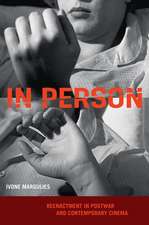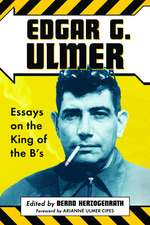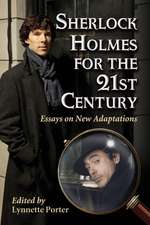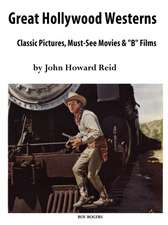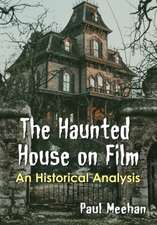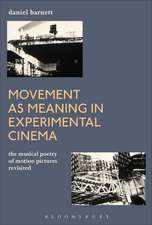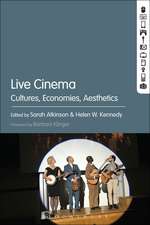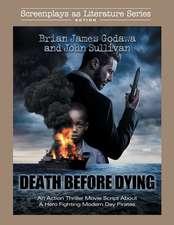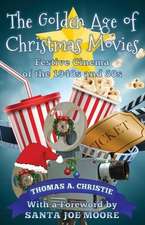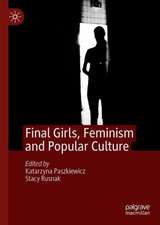Reframing Cult Westerns: From The Magnificent Seven to The Hateful Eight
Editat de Dr Lee Broughtonen Limba Engleză Paperback – 22 sep 2021
| Toate formatele și edițiile | Preț | Express |
|---|---|---|
| Paperback (1) | 218.00 lei 6-8 săpt. | |
| Bloomsbury Publishing – 22 sep 2021 | 218.00 lei 6-8 săpt. | |
| Hardback (1) | 569.37 lei 6-8 săpt. | |
| Bloomsbury Publishing – 18 mar 2020 | 569.37 lei 6-8 săpt. |
Preț: 218.00 lei
Preț vechi: 275.07 lei
-21% Nou
Puncte Express: 327
Preț estimativ în valută:
41.71€ • 43.67$ • 34.52£
41.71€ • 43.67$ • 34.52£
Carte tipărită la comandă
Livrare economică 05-19 aprilie
Preluare comenzi: 021 569.72.76
Specificații
ISBN-13: 9781501386893
ISBN-10: 1501386891
Pagini: 256
Ilustrații: 4 bw illus
Dimensiuni: 152 x 229 mm
Greutate: 0.36 kg
Editura: Bloomsbury Publishing
Colecția Bloomsbury Academic
Locul publicării:New York, United States
ISBN-10: 1501386891
Pagini: 256
Ilustrații: 4 bw illus
Dimensiuni: 152 x 229 mm
Greutate: 0.36 kg
Editura: Bloomsbury Publishing
Colecția Bloomsbury Academic
Locul publicării:New York, United States
Caracteristici
Employs a variety of critical-but-accessible theories and approaches in order to offer new insights into Westerns that have - to differing degrees - been somewhat overlooked by previous books on the genre
Notă biografică
Dr. Lee Broughton is a freelance writer, critic, film programmer and lecturer in film and cultural studies. He is the author of The Euro-Western: Reframing Gender, Race and the 'Other' in Film (2016) and the editor of Critical Perspectives on the Western: From A Fistful of Dollars to Django Unchained (2016). He has contributed chapters and articles to numerous edited collections and academic journals.
Cuprins
Introduction: Cult Westerns and Cult FilmsLee BroughtonPart One: Classic Cult Westerns1. "It seemed like a good idea at the time": Hollywood, Homology and Hired Guns - The Making of The Magnificent SevenPaul Kerr, Middlesex University, UK2. The Historical Accuracy of Sergio Leone's The Good, the Bad and the UglyPeter J. Hanley, University of Münster, Germany3. Where White Men Dream Out Loud: Robert Altman's WestCynthia J. Miller, Emerson College4. The Gold Rush: The New Right and the Westerns of 1980Craig Ian Mann, Sheffield Hallam University, UKPart Two: Charting New Frontiers and Mapping Identity and Politics in International Cult Westerns5. Landscape, imagery and symbolism in Alejandro Jodorowsky's El TopoMatt Melia, Kingston University, UK6. Dancing with Death: Whity, a Singular WesternHamish Ford, University of Newcastle, Australia7. Man of the West: Dean Reed's (Cinematic) Frontier Personas in Blood Brothers and Sing, Cowboy, Sing!Sonja Simonyi, independent scholar, Hungary 8. An(Other) West: The Limits of National Identity in The PropositionChelsea Wessels, East Tennessee State University, USAPart Three: Contemporary Cult Westerns and Contemporary Concerns9. The return of the repressed: locating the supernatural in US Civil War WesternsLee Broughton (Independent scholar, UK)10. Stranger and Friend: Non-American Westerns and the Immigrant in the Twenty-First CenturyJenny Barrett, Edge Hill University, UK11. The Intrusion of Climate in The RevenantJack Weatherston, independent scholar, UK12. "Hand in hand we'll get there": The Racial Politics of The Hateful EightThomas Moodie, freelance writer and script supervisor, UKList of ContributorsIndex
Recenzii
[An] exceptional look at what has become of the contemporary western.
Once the backbone of Hollywood production, the Western film has - since the 1960s - moved to the margins, often into the world of midnight movies and cults. Most studies of the Western tend to lose interest in the genre when it ceased to be mainstream - which is precisely where Reframing Cult Westerns begins. The various essays in the book, curated by Lee Broughton, examine films which set out to be cults, and films which didn't but which have turned into cults over time. They revisit classic Westerns through the prism of more recent generic developments. They treat the Western as a global text, including examples from Australia and Argentina, Mexico and Italy, Denmark and Scotland, East and West Germany. The result is not only a reframing of some cult Westerns, but a reframing of our understanding of the Western film. Maybe it hasn't headed for the last roundup after all...
Lee Broughton has compiled an exciting collection of essays that draws together a range of contemporary approaches to studying the cult Western. For anyone wanting to find out why the genre remains crucial for our understanding of the United States and its role in the world, and for anyone interested in making sense of the genre's place within a global cultural context, this is a must-have book.
An adventurous and illuminating collection, throwing light on many marginal, even eccentric films, and demonstrating that the Western still has many ways of exciting and intriguing us.
Seen through the lens of cult cinema, the Western, that most familiar of movie genres, takes on exciting and often unexpected new meanings. Whether providing fresh perspectives on familiar works or drawing our attention to understudied films and trends, these essays serve as a valuable reminder of the Western's vibrancy over the past half-century, and of the expressive possibilities it still offers filmmakers today.
Once the backbone of Hollywood production, the Western film has - since the 1960s - moved to the margins, often into the world of midnight movies and cults. Most studies of the Western tend to lose interest in the genre when it ceased to be mainstream - which is precisely where Reframing Cult Westerns begins. The various essays in the book, curated by Lee Broughton, examine films which set out to be cults, and films which didn't but which have turned into cults over time. They revisit classic Westerns through the prism of more recent generic developments. They treat the Western as a global text, including examples from Australia and Argentina, Mexico and Italy, Denmark and Scotland, East and West Germany. The result is not only a reframing of some cult Westerns, but a reframing of our understanding of the Western film. Maybe it hasn't headed for the last roundup after all...
Lee Broughton has compiled an exciting collection of essays that draws together a range of contemporary approaches to studying the cult Western. For anyone wanting to find out why the genre remains crucial for our understanding of the United States and its role in the world, and for anyone interested in making sense of the genre's place within a global cultural context, this is a must-have book.
An adventurous and illuminating collection, throwing light on many marginal, even eccentric films, and demonstrating that the Western still has many ways of exciting and intriguing us.
Seen through the lens of cult cinema, the Western, that most familiar of movie genres, takes on exciting and often unexpected new meanings. Whether providing fresh perspectives on familiar works or drawing our attention to understudied films and trends, these essays serve as a valuable reminder of the Western's vibrancy over the past half-century, and of the expressive possibilities it still offers filmmakers today.

